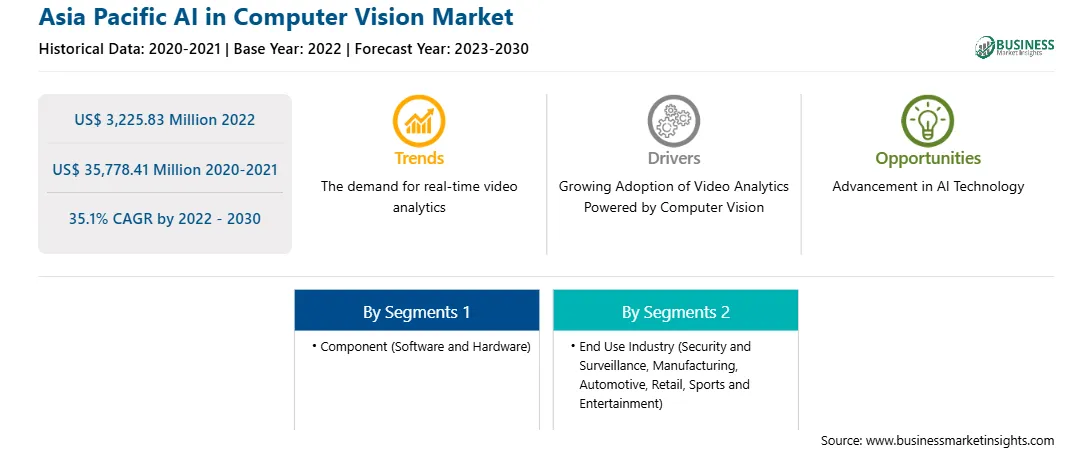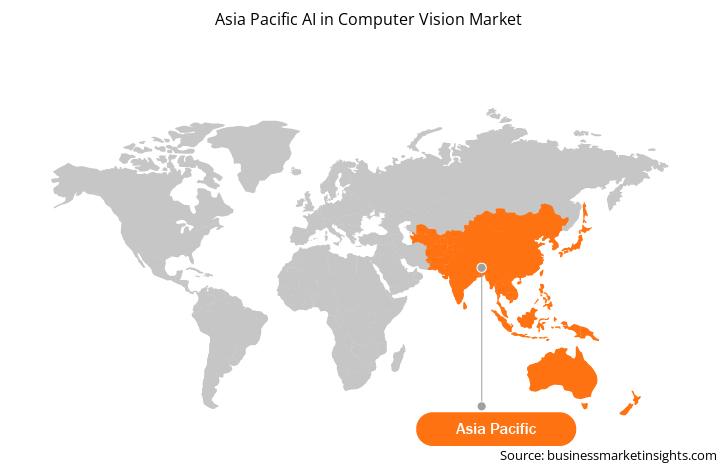The Asia Pacific AI in computer vision market was valued at US$ 3,225.83 million in 2022 and is expected to reach US$ 35,778.41 million by 2030; it is estimated to record a CAGR of 35.1% from 2022 to 2030.
Computer vision is a fundamental technology for developing autonomous or self-driving vehicles. It provides the necessary perception capabilities, enabling vehicles to navigate and operate safely without human intervention. Computer vision algorithms can interpret complex visual data, including traffic signs, lane markings, traffic lights, and road conditions. This allows autonomous vehicles to make informed decisions about their movements and adjust their behavior accordingly. Computer vision is at the center of autonomous vehicle technology. By leveraging object detection algorithms while also using the latest cameras and sensors, autonomous vehicles get to identify their surroundings, making the entire driving process safer. Computer vision models allow autonomous vehicles to stop before they hit walkers or cyclists. Various companies are launching new autonomous vehicles. For instance, in June 2023, Minus Zero unveiled the zPod, which it claimed to be India's first autonomous vehicle. The zPod showcased self-driving tech developed by the artificial intelligence (AI) firm. Minus Zero said that it would provide its autonomous driving tech to other manufacturers to help improve their ADAS suite. Therefore, the increasing manufacturing of autonomous vehicles is anticipated to provide growth opportunities for the AI in computer vision market.
Asia is at the forefront of the global digital revolution. Asian companies are far out-maneuvering their Western counterparts due to the advantage of setting up robust digital operations from basically a blank slate in terms of factory workforce, automation, and even organization information technology networks. Various companies in APAC are launching new automation centers. For instance, in December 2022, OMRON, a company operating in the factory automation industry, announced that it would be serving the logistics sector in Southeast Asia, Singapore, and Oceania with its first automation center, which was launched in 2022. The company Omron expanded its automation center, which offers Industry 4.0 solutions. It’s automation center is one of the solution development centers that supports the implementation of the Robotics Middleware Framework (RMF) in the logistics industry. It is known as Omron Automation Center Singapore for Logistics.
Furthermore, various companies are launching new autonomous vehicles in APAC. For example, in July 2022, Baidu, Inc. announced its next-generation completely autonomous vehicle (AV), Apollo RT6, a production-ready model with a removable steering wheel. It was designed for complex urban environments; Apollo RT6 was put into operation in China in 2023 on Apollo Go autonomous ride-hailing service. Similarly, in May 2021, SK Holdings partnered with Kodiak Robotics, to target US$ 1290 billion in Asia Pacific autonomous driving. Kodiak Robotics provided SK Corporation with autonomous driving systems, such as advanced emergency braking systems and artificial intelligence (AI) microprocessors. The computer vision technology is used widely in autonomous vehicles Therefore, with such increasing instances, the AI in computer vision market is growing in Asia Pacific.
Strategic insights for the Asia Pacific AI in Computer Vision provides data-driven analysis of the industry landscape, including current trends, key players, and regional nuances. These insights offer actionable recommendations, enabling readers to differentiate themselves from competitors by identifying untapped segments or developing unique value propositions. Leveraging data analytics, these insights help industry players anticipate the market shifts, whether investors, manufacturers, or other stakeholders. A future-oriented perspective is essential, helping stakeholders anticipate market shifts and position themselves for long-term success in this dynamic region. Ultimately, effective strategic insights empower readers to make informed decisions that drive profitability and achieve their business objectives within the market.

| Report Attribute | Details |
|---|---|
| Market size in 2022 | US$ 3,225.83 Million |
| Market Size by 2030 | US$ 35,778.41 Million |
| Global CAGR (2022 - 2030) | 35.1% |
| Historical Data | 2020-2021 |
| Forecast period | 2023-2030 |
| Segments Covered |
By Component
|
| Regions and Countries Covered | Asia-Pacific
|
| Market leaders and key company profiles |
The geographic scope of the Asia Pacific AI in Computer Vision refers to the specific areas in which a business operates and competes. Understanding local distinctions, such as diverse consumer preferences (e.g., demand for specific plug types or battery backup durations), varying economic conditions, and regulatory environments, is crucial for tailoring strategies to specific markets. Businesses can expand their reach by identifying underserved areas or adapting their offerings to meet local demands. A clear market focus allows for more effective resource allocation, targeted marketing campaigns, and better positioning against local competitors, ultimately driving growth in those targeted areas.

The Asia Pacific AI in computer vision market is segmented based on component, end use industry, and country. Based on component, the Asia Pacific AI in computer vision market is bifurcated into software and hardware. The software segment held a larger market share in 2022.
In terms of end use industry, the Asia Pacific AI in computer vision market is categorized into security and surveillance, manufacturing, automotive, retail, sports and entertainment, and others. The security and surveillance segment held the largest market share in 2022.
Based on country, the Asia Pacific AI in computer vision market is segmented into China, Japan, India, Australia, South Korea, and the Rest of Asia Pacific. China dominated the Asia Pacific AI in computer vision market share in 2022.
Advanced Micro Devices Inc, Cognex Corp, General Electric Co, Intel Corp, Microsoft Corp, Qualcomm Inc, Teledyne Technologies Inc, NVIDIA Corp, BASLER AG, and International Business Machines Corp are some of the leading players operating in the Asia Pacific AI in computer vision market.
The Asia Pacific AI in Computer Vision Market is valued at US$ 3,225.83 Million in 2022, it is projected to reach US$ 35,778.41 Million by 2030.
As per our report Asia Pacific AI in Computer Vision Market, the market size is valued at US$ 3,225.83 Million in 2022, projecting it to reach US$ 35,778.41 Million by 2030. This translates to a CAGR of approximately 35.1% during the forecast period.
The Asia Pacific AI in Computer Vision Market report typically cover these key segments-
The historic period, base year, and forecast period can vary slightly depending on the specific market research report. However, for the Asia Pacific AI in Computer Vision Market report:
The Asia Pacific AI in Computer Vision Market is populated by several key players, each contributing to its growth and innovation. Some of the major players include:
The Asia Pacific AI in Computer Vision Market report is valuable for diverse stakeholders, including:
Essentially, anyone involved in or considering involvement in the Asia Pacific AI in Computer Vision Market value chain can benefit from the information contained in a comprehensive market report.